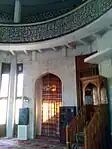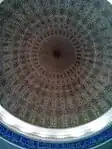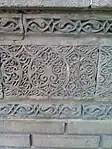Al-Khulafa Mosque
Al-Khulafa Mosque (Arabic: جامع الخلفاء, romanized: Jami' Al-Khulafa) is a historic Sunni Islamic mosque located in Baghdad, Iraq. It is located on the Jumhuriya Street in al-Rusafa side of the city. It is the oldest surviving mosque in Baghdad.[1] The mosque, along with its minaret, was completely rebuilt and restored in the 1960s by the Ministry of Awqaf in its current shape to this day.[2]
| Al-Khulafa Mosque Al-Qasr Mosque | |
|---|---|
 | |
| Religion | |
| Affiliation | Islam |
| Rite | Sunni Islam |
| Ecclesiastical or organisational status | Mosque |
| Status | Active |
| Location | |
| Location | Baghdad, Iraq |
 Shown within Baghdad | |
| Geographic coordinates | 33.3388633°N 44.3977341°E |
| Architecture | |
| Type | Mosque |
| Style | Abbasid architecture |
| Founder | Al-Muktafi |
| Groundbreaking | 902 CE |
| Completed | 908 CE |
| Specifications | |
| Minaret(s) | 1 |
| Minaret height | 34 metres (112 ft) |
The minaret dates back to the time of the Abbasid Caliphate and has been standing for 1,200 years and used to be the highest point in Baghdad. Due to this, the mosque is referred to as one of the most important Islamic and historic landmarks in the city. However, in recent years the mosque is threatened with collapse due to neglect from the Iraqi government.[3]
Historical background
Abbasid foundation and post-Abbasid Caliphate

The mosque dates back to the Abbasid era and was commissioned by the 17th Abbasid Caliph, al-Muktafi (r. 902–908), as a Friday mosque for the sprawling palace complex erected by him and his father, Caliph al-Mu'tadid. Due to this, the mosque is often also called al-Qasr Mosque (Arabic: جامع القصر) which literally means the "mosque of the palace" in Arabic. Later the mosque was dubbed as the Mosque of Caliph, which gave the current name Al-Khulafa. As a result of its significant age, the mosque is one of the historic landmarks of the city of Baghdad. Al-Khulafa Mosque was also notably mentioned in the Ibn Battuta’s travel record when he visited Baghdad in 1327. The mosque has also suffered through many wars to the point that only the original minaret remained of it throughout its existence.[4][5]
The most notable part of the mosque is its 34-metre (112 ft) minaret which is still surviving in its original form dating back to the Abbasid era. The minaret is the only part remaining from the original construction. It is set on the southeast corner of the sahn and constructed in brick and mortar. The minaret and its foundation are decorated with muqarnas, and the frame of the minaret is engraved with Kufic inscriptions and Islamic geometric patterns.[2] During James Silk Buckingham's visit to Baghdad in 1816, al-Khulafa Mosque was one of the mosques he visited which was located in Souk al-Ghazil and noted how the remains of the mosque and the minaret looked like they were effected by "marks of violence." Due to the location of the mosque, Buckingham called it the "Souk al-Ghazil Mosque. He noted in his travels:
The body of the original building appears to have been destroyed by violence. No more remains of it at present than the minaret and a small portion of the outer walls. The former of these is a short, thick, heavy column, of the most graceless proportions, built of bricks, diagonally crossed, and varied on colours, as in the minaret of the Great Mosque at Mousul.[6]
Restoration and later events

The minaret was refurbished in 1960 and a project by the Ministry of Awqaf was carried out to rebuild the mosque and hiring architect Mohamed Makiya for the major project. The project was completed in 1964 in the mosque's current form with Mohamed drafting proposals to rehabilitate the mosque in 1981.[2] However, today there is a concern of its collapsing due to the lack of maintenance allegedly stemming from the sectarian divide between the Sunni-oriented mosque and the Shi'i-majority government.[7] Because of the minaret's tilt, the mosque is better known by locals as "al-Ahdab" (Arabic: الأحدب), meaning "the hunchback".[8]
A spokesman for the Ministry of Culture, Ahmed al-Olayawi, commented on the delay in restoring the mosque by saying that the rehabilitation of the mosque and its minaret is not easy, because this site extends for hundreds of years and is considered a historical landmark of Baghdad, and therefore it needs deep studies before starting. A British committee of experts is currently studying the mosque to rehabilitate the mosque.[3] The Sunni Endowment Office has also concluded an agreement with UNESCO in 2017 in order to preserve the mosque.[9]
Among the scholars who held the position of imam and rhetoric in the mosque was Sheikh Jalal al-Din al-Hanafi, who was the imam of the mosque for several decades and helped in the maintenance and preservation of the mosque such as the fence which is decorated by Islamic calligraphy.[10] Al-Hanafi was also bold in his position as he prevented the installation of loudspeakers in the mosque and instead preferred to do the call of prayer on the pulpit. This decision was because loudspeakers "annoy non-Muslims, children, the sick, and the elderly, and there is no need for them. People watch and know prayer times from the radio and television." Al-Hanafi was known to have great love for al-Khulafa Mosque due to its age and architecture; to this day, the mosque is sometimes associated with al-Hanafi since he spent many time in the mosque.[11]
Architecture
Current layout and structure
When restoring the mosque, architect Mohamed Makiya wanted the mosque's design to be as accurate to Islamic architecture during the Abbasid period as possible, as such the intention was to make the mosque as if was never demolished previously. There are three gates that lead to the chapel of the mosque which is octagonal in shape and topped with a 14 meter dome decorated with Kufic script. The mosque was colored in the same yellow-ish colors in order to match the color of the minaret and the mosque is decorated in many Islamic and geometric shapes.[12]
- Gallery of the Mosque's features
 The prayer space of the mosque.
The prayer space of the mosque. Interior detail of the Khulafa Mosque's big dome.
Interior detail of the Khulafa Mosque's big dome. Islamic decoration on the mosque's stones and bricks.
Islamic decoration on the mosque's stones and bricks. The exterior of the mosque's building.
The exterior of the mosque's building. A window.
A window.
Minaret
The most significant part of the mosque is its minaret which dates back to the Abbasid period and is the most preserved part of the mosque. It is about 35 meters high with a cylindrical shape that includes four layers of muqarnas supporting the base of the minaret.[12] The minaret is similar in terms of design to the minaret of Bastam in Iran, which was built in 1120, and is similar to the minaret of al-Nukhailah Mosque.[1]
- Gallery of the Abbasid Minaret
 The Abbasid minaret as seen from ground level.
The Abbasid minaret as seen from ground level. Ground level view of the first bands of the muqarnas and the decorations of the minaret.
Ground level view of the first bands of the muqarnas and the decorations of the minaret. The four bands of muqarnas below the minaret.
The four bands of muqarnas below the minaret. Closeup of the muqarnas and their decorations which date back to the Abbasid era.
Closeup of the muqarnas and their decorations which date back to the Abbasid era.
References
- The Book of Mosques of Baghdad - written by Dr. Younis Al-Samarrai - Chapter One, Old Rusafa Mosques: The Mosque of the Caliphs - Page 22.
- Khulafa Central Mosque. Archnet. Retrieved January 5, 2018.
- الصالحي, رامي. "منارة جامع الخلفاء في بغداد مهددة بالانهيار.. والسلطات لا تعير اهتماما رغم مكانته التاريخية". www.aljazeera.net (in Arabic). Retrieved 2023-08-15.
- كتاب دليل خارطة بغداد المفصل - تأليف الدكتور مصطفى جواد والدكتور أحمد سوسة - مطبعة المجمع العلمي العراقي. 1958. p.125.
- "أمانة مجلس الوزراء تتحرك لانقاذ مئذنة أثرية من السقوط". شفق نيوز. Retrieved 2023-08-15.
- Buckingham, James Silk (1827). Travels in Mesopotamia. H. Colburn.
- Why is Khulafa Mosque's minaret on verge of collapse? Al Monitor. Retrieved January 5, 2018.
- "The Taj Mahal And The Golden Age Of Islam". Ancient Engineering. Season 1. Episode 10. 2021. Event occurs at 21:49. CuriosityStream.
- "مدير عام الدائرة الهندسية يتفقد مأذنة جامع الخلفاء - ديوان الوقف السني". 2020-01-10. Archived from the original on 2020-01-10. Retrieved 2023-08-16.
- دليل الجوامع والمساجد التراثية والأثرية - ديوان الوقف السني في العراق - صفحة 18، 19.
- "الگاردينيا - مجلة ثقافية عامة - جلال الدين الحنفي شيخ بغداد وعاشقها". www.algardenia.com. Retrieved 2023-09-15.
- "جامع الخلفاء في بغداد تحفة معمارية لمحمد مكية - المشاهير". 2020-01-10. Archived from the original on 2020-01-10. Retrieved 2023-08-16.
